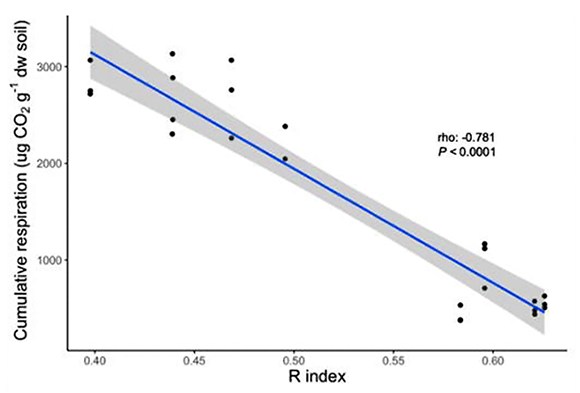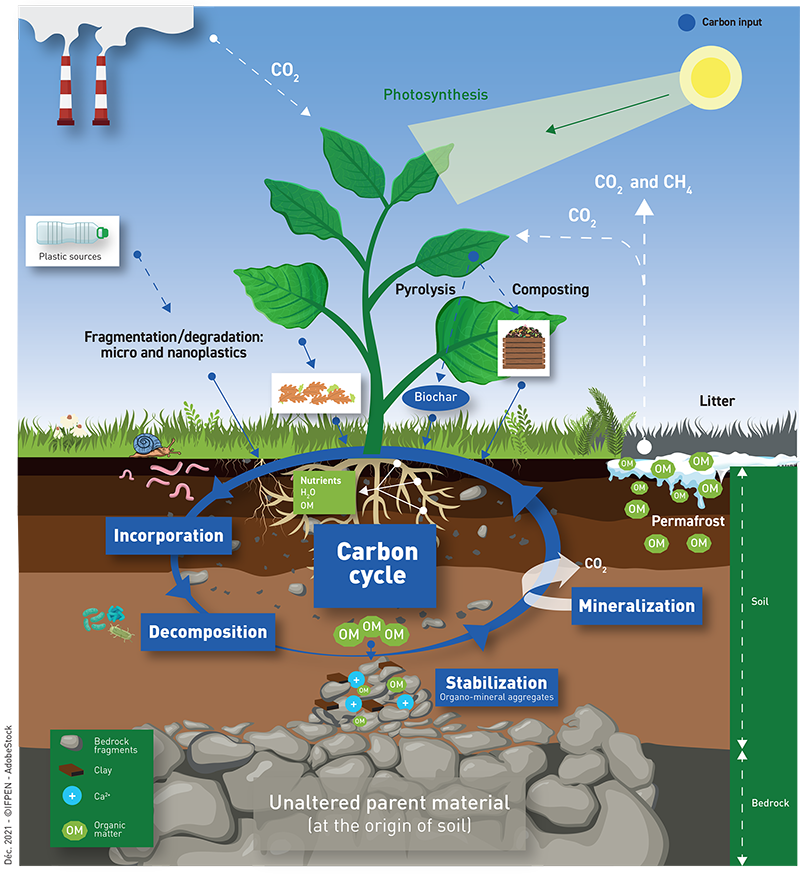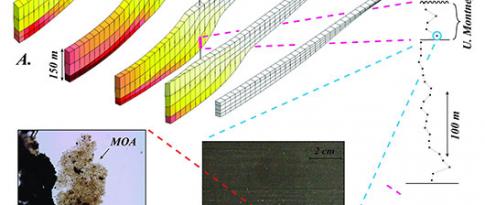One way to decrease the amount of atmospheric CO2 is to reduce greenhouse gas emissions of fossil origin, but it is also possible to increase the quantities of carbon stored in the soil. This option brings into play soil organic matter (SOM), categorized into three functional groups depending on the speed with which CO2 decomposes: fast (from a few days to a year), intermediate (from a few years to a few decades) or slow (from several decades to more than a century). In connection with the chemical composition of organic matter, the time the latter remains in the soil depends on its interactions with the minerals present and its mineralization induced by the action of microorganisms.
In the current context of climate change, understanding the evolution of carbon in the ground is critically important. It is for this reason that IFPEN wanted to study the potential offered by Rock-Eval®, a flagship of oil research, as a tool that can be used to provide reliable and fast characterization data. This characterization is based on simpler thermal analyses than the fractionation and incubation protocols currently proposed in soil and environmental sciences. The efficiency of the method, which consists in subjecting samples to heating programs (pyrolysis and combustion), has been widely demonstrated in the oil and gas context to characterize organic matter, both qualitatively and quantitatively[1]. By differentiating carbon fractions of varying thermal stabilities (labilea, resistant and refractory), the method also makes it possible to identify the different functional categories of SOM and demonstrate the capacity of samples to mineralize.
Thus an original method using Rock-Eval® was recently developed at IFPEN to better quantify soil organic carbon (SOC) and soil inorganic carbon (SIC) (patents pending), at the same time providing a better understanding of COS stability. In this respect, two new functional criteria based on the analysis of the pyrolysis thermogram were identified to represent and monitor the mineralization and stabilization dynamics of carbon on a diagram[2].
This new approach was applied to a series of soil samples taken from different depths in a managed beech forest in Normandy (France), records for which date back 200 years[3]. This study highlighted a relationship between the particle size of the soil fractions and the thermal stability of the SOM, probably indicating its biogeochemical stability. These field results were corroborated by incubation experiments on a model soil (figure 1), which established the link between microbial diversity, the molecular complexity and the thermal stability of the SOM[4]. Similarly, the impact of adding a mixture of biocharb and organic fertilizer on fertility and long-term carbon sequestration in the ground[5] was studied.

(R-Index: descriptor of SOC stability obtained from the Rock-Eval® analysis) [4]
This recently acquired expertise by IFPEN is already being used in collaborative projects:
- an ANR (French National Research Agency) project aimed at gaining a better understanding of the impact of plastics on soil ecosystems[6];
- a Belmont Forum project focusing on the impact of recent climate changes and the use of arctic and equatorial soils on carbon storage[7].
Original and promising for carbon characterization in soils in numerous pedologicc and agronomic contexts (figure 2), these activities illustrate IFPEN’s capacity to transfer expertise in order to address the challenges of the environmental transition.
Click on the picture to enlarge

a- Unstable.
b- Solid carbon-rich residue obtained via the pyrolysis of organic matter of diverse origins (agricultural residues, manure, forestry residues, etc.).
c- Relating to the study of soils.
Publications:
[1] https://www.ifpenergiesnouvelles.com/brief/rock-evalr-thermal-analysis-rocks-and-soils
[2] Sebag D., Verrecchia E.P., Cécillon L., Adatte T., Albrecht R., Aubert M., Bureau F., Cailleau G., Copard Y., Decaens T., Disnar J.-R., Hetényi M., Nyilas T., Trombino L., 2016. Geoderma 284, 185-203. https://doi.org/10.1016/j.geoderma.2016.08.025.
[3] Sebag D., Verrecchia E.P., Adatte T., Aubert M., Cailleau G., Decaens T., Kowalewski I., Trap J., Bureau F., Hedde M., 2021. Pedosphere, 2021, in press.
[4] Domeignoz-Horta L. A., Shinfuku M., Junier P., Poirier S., Verrecchia E., Sebag D., De Angelis M., ISME COMMUN., accepted (preprint https://doi.org/10.1101/2021.04.23.441131).
[5] Aubertin M.L., Sebag D., Jouquet P., Girardin C., Houot S., Kowalewski I., Lamoureux-Var V., Pillot D., Rumpel C., 2021. Eurosoil 2021 (virtual congress), 23-27 août 2021, oral paper.
[6] ANR e-Dip project: “Dynamique environnementale et impacts des cocktails de contaminants provenant des plastiques dans les écosystèmes terrestres” (Environmental dynamics and impacts of cocktails of contaminants from plastics in land ecosystems). Project coordinator: Marie-France Dignac, INRAE, iEES Paris.
[7] Projet VULCAR-FATE : ”Global change impact on vulnerable carbon reservoirs: carbon sequestration and emissions in soils and waters From the Arctic To the Equator”, financed by the Belmont Forum. Project coordinator: Jean-Jacques Braun, IRD, Géosciences Environnement Toulouse.
Scientific contact: Isabelle Kowalewski
You may also be interested in
Violaine Lamoureux-Var, winner of the FIEEC CARNOT Prize for Rock-Eval® 7S
The energy transition and geothermal energy: Knowledge that is difficult to uncover
Rock-Eval® : to find out more
Méthodes analytiques (détails), interprétation pour l’exploration pétrolière, littérature









